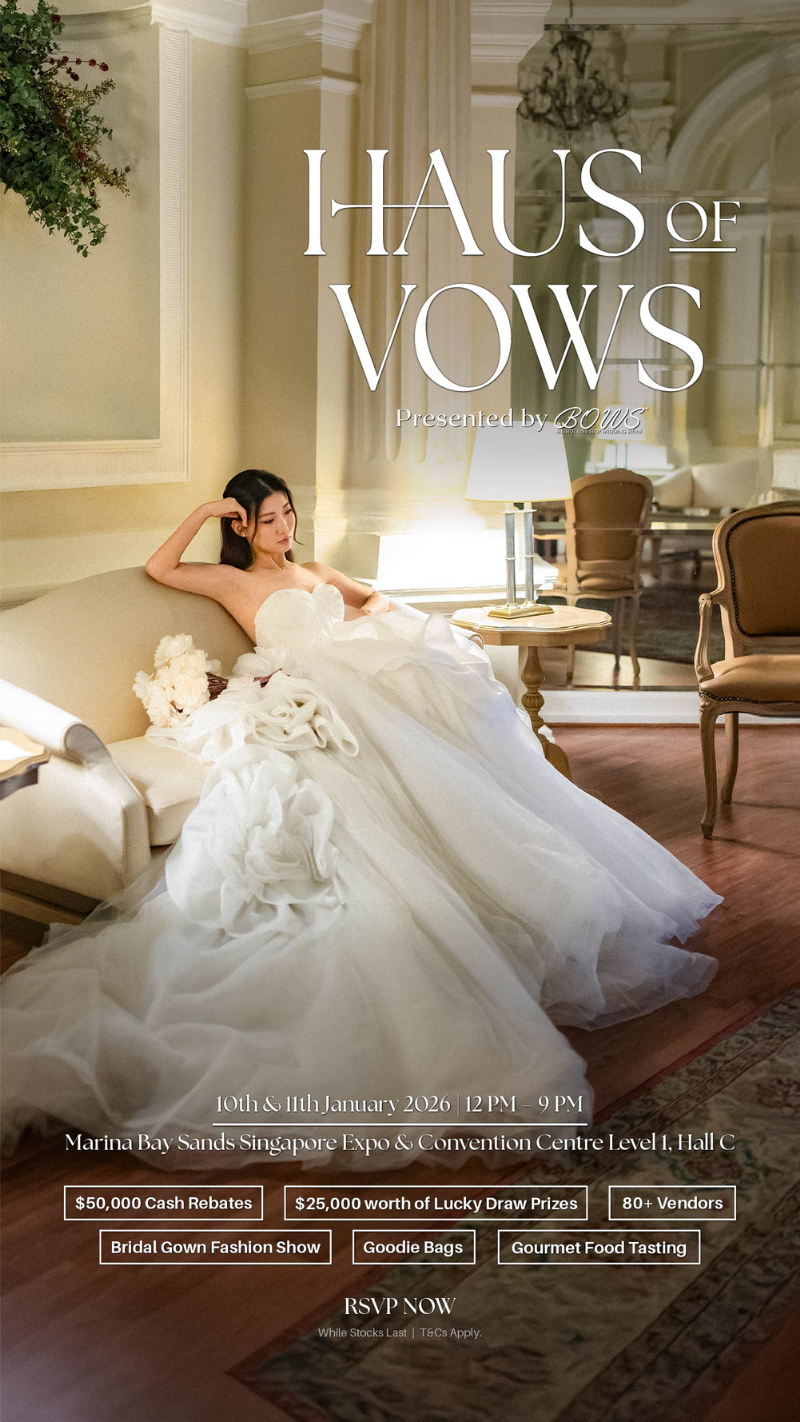Wedding Traditions (Part 1) — Cantonese and Hakka
2017-04-26
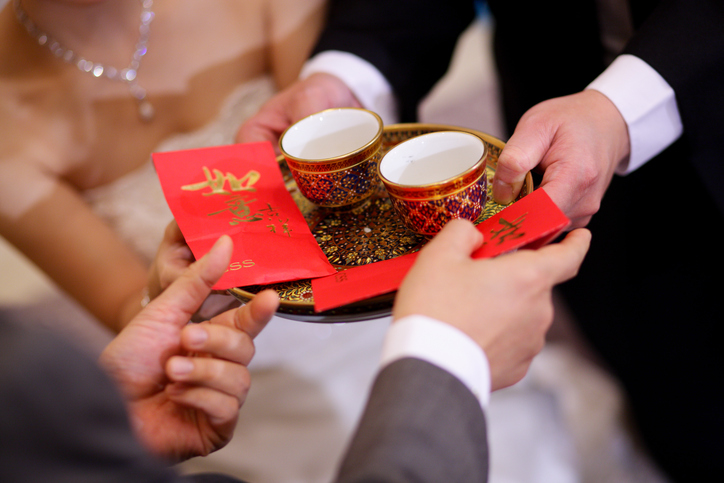
Perhaps you are compelled by your elders to perform certain traditional Chinese wedding customs, or maybe you want to do it on your own accord. Regardless, Blissful Brides is here to help you honour your heritage and give you a kickstart in familiarising yourselves with the traditions of your dialect.
To start off our weekly Wedding Traditions series, we focus on the Cantonese and Hakka community. The practices revolve around the fact that marriage not only brings together two individuals, but unites two families as well, thus they comprise of many gestures which signify respect and gratitude. Let’s take a look.
Betrothal Ceremony / Guo Da Li 过大礼
To begin, an appointed matchmaker (媒婆) will help both families come together and pick an auspicious date for the Betrothal Ceremony, which acts as an official marriage proposal. The groom’s family will present a set of gifts to the bride’s family and once the latter accepts the offerings, both sides will choose an auspicious date for the wedding. Afterwards, the bride’s family will return a portion (usually half) of the gifts received to express their hopes that the two families will maintain a good relationship with each other.
As we go along, you will see that the matchmaker carries a fair load of responsibilities throughout the entire wedding process — definitely more than just “matchmaking”.
Setting up the Matrimonial Bed / An Chuang 安床
Depending on the flexibility of both families, the matrimonial bed will usually be set a few days to a week before the wedding. Ideally, a lady “of good fortune” (happily married, in the pink of health and has children) will set up the bed, but it can also be done by the groom’s parents or a married couple (of good fortune) from the family.
There are several rules that follow this practice; fresh linen of an auspicious colour (commonly red, with dragon or phoenix embroidery) will be lain, items signifying fertility and prosperity are arranged on the bed, and the bed itself will be moved slightly to mark its installation. Then, several chants will be recited to bless the couple:百年好合 (may the couple have a blissful marriage), 早生贵子(may the couple be blessed with offsprings), 白头偕老 (may the couple grow old together), and 永浴爱河 (may the couple be in love for eternity). Once everything is done, it is bad omen to have anyone in the room before the couple themselves enter on their wedding day (it implies that there will be the presence of a third party in the marriage).
Fetching the Bride / Ying Qin 迎亲
As the groom sets off to fetch his bride from her home on the day of the wedding, he will be accompanied by his groomsmen. He will not be empty-handed — he has to take with him a bouquet of flowers for the bride, as well as gifts that signifies good fortune for the bride’s family.
One of the bride’s younger male relative will greet the groom upon his arrival. At this point, the groom will hand over an ang bao to the relative, and the latter will return the gesture with two mandarin oranges as symbols of good luck.
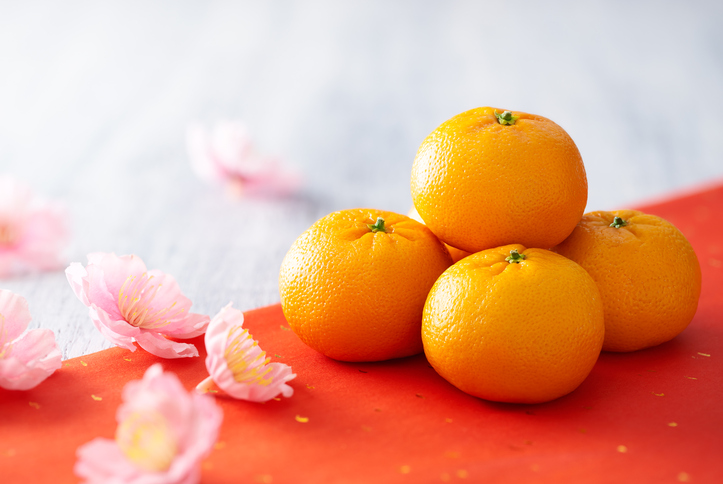
There is yet another obstacle for the groom before he gets to lay eyes on his beloved bride: the infamous “gatecrash”. Bridesmaids gang up against the groom and groomsmen to block the entry to the bride’s home. The men will only be allowed to enter after completing a series of “quests” set by the bridesmaids and present another ang bao, the Door Opening Ang Bao (开门红包), with an amount deemed satisfactory by the ladies.
Traditions aside, we believe that Groom & Co. would definitely need all the luck from the mandarin oranges earlier to get them through the gatecrash.
When the groom finally meets his beautiful bride, he will present the bouquet he brought. According to Cantonese traditions, the groom also has to find the bride’s red wedding shoes and put them on her.
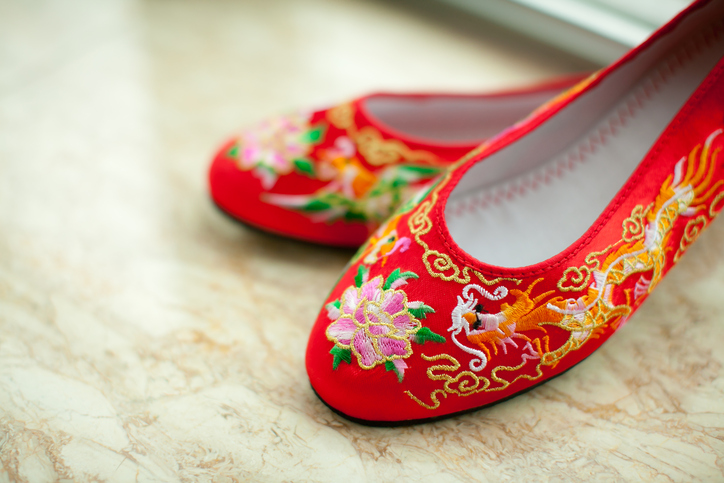
Prayers will then be made to heaven, earth and the couple’s ancestors. With a bow of gratitude to the bride’s parents, the groom will make his way back to his home, this time with his bride in tow.
Leaving the Bride's House / Chu Ge 出阁
From the moment the bride steps out of her house, she is to be protected like royalty — either the matchmaker, the maid of honour or the bride’s father will shelter her with a red umbrella to ward off any negative elements. The matchmaker will also have throw rice grains and/or red beans (symbols of good luck) on the way to the bridal car.
Before the couple is driven off, the bride will throw a foldable fan out of the window to express that she is leaving her past behind to embark on the new chapter of her life. Later, as she leaves the car to walk to the groom’s place, the bride will once again be sheltered by the red umbrella.
Entering the Groom's Home / Guo Men 过门
It is customary for the groom’s family to "hide" in a separate room when the couple reaches the house. The action expressed their hopes that there will not be any disputes between the bride and her new family in the future. They can come out when they couple has entered the bridal room.
Before entering the bridal room, the couple will once again pray to heaven, earth and their ancestors. Inside the bridal room, they will be served sweet soup (usually with longans, red dates, lotus seeds, hard-boiled eggs and rice balls) and mee sua, which symbolise a sweet marriage and longevity, respectively.
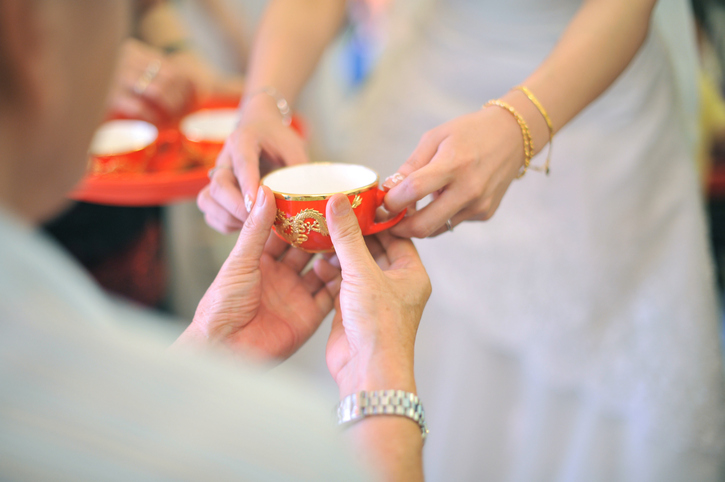
The Tea Ceremony or Jin Cha (敬茶) will then commence. The couple will kneel in front of their elders to serve them sweet longan tea and in return, the couple will receive red packets and gifts. In contrast, the couple will be served tea by those younger than them. Throughout the entire ritual, the bride is to remain on the groom’s right side.
Once the Tea Ceremony is concluded, a young boy may be asked roll around on the couple’s bed to bless the couple with many children.
The Bride’s Homecoming / San Chao Hui Men 三朝回门
To wrap everything up, the bride will once again return to her home. Traditionally, the homecoming will take place three days after the wedding, however in present day, the bride may return on the same day. She will, however, have to change to a different wedding outfit, to give the impression that three days have passed since her earlier departure.
Once again, gifts will be exchanged. This time around, the groom come along bearing a whole roasted pig (traditionally as a sign of the bride's virginity) for the bride’s family. The pig will be divided into three parts — the head and the hind will be returned to the groom’s family (along with other gifts like sugar canes to symbolise a sweet marriage and mandarin oranges for good luck), whereas the bride’s family will keep the middle portion.

